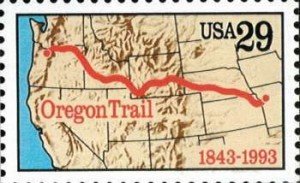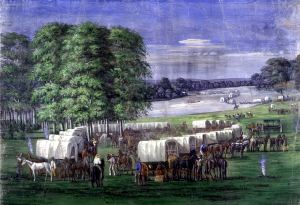The American Frontier Woman
I think it can be said that the vast majority of stories about our American West have been written from the perspective of the male. A journey to and inside the old American frontier west was filled with dangers and perhaps because the male was considered the protector and usually the provider, the stories were a reflection of those challenges.
Thank you for reading this post, don't forget to subscribe! One of the most significant dangers faced by white settlers during the days of the old west was the Indian menace. This again was the responsibility of the male to protect against. Certainly the stories of Indian Wars and buffalo hunting are what popular western novels and historic pieces are made of, but the contribution of females on the western frontier, although very under publicized, were equally important in many aspects. In most cases the women traveled to the frontier after the males, such as the first gold prospectors in California and the fur traders before that, but they did emigrate there and in greater numbers with the among the Oregon Trail wagon trains. Some historians contend that true civilization didn’t come to the western frontier until the pioneer women made their presence. On top of all the other duties of a pioneer woman, there is no doubt that the pioneer women cooks changed the living standards much to the better. The image below is of Narcissa Whitman, a missionary who was massacred with her husband by Indians after an disease outbreak in the year 1847 near present day Walla Walla Washington.
One of the most significant dangers faced by white settlers during the days of the old west was the Indian menace. This again was the responsibility of the male to protect against. Certainly the stories of Indian Wars and buffalo hunting are what popular western novels and historic pieces are made of, but the contribution of females on the western frontier, although very under publicized, were equally important in many aspects. In most cases the women traveled to the frontier after the males, such as the first gold prospectors in California and the fur traders before that, but they did emigrate there and in greater numbers with the among the Oregon Trail wagon trains. Some historians contend that true civilization didn’t come to the western frontier until the pioneer women made their presence. On top of all the other duties of a pioneer woman, there is no doubt that the pioneer women cooks changed the living standards much to the better. The image below is of Narcissa Whitman, a missionary who was massacred with her husband by Indians after an disease outbreak in the year 1847 near present day Walla Walla Washington.

I think it’s safe to say that history books have publicized the women bent on mischief and thievery somewhat more than the woman of virtue. The reason might simply be that it makes for more colorful copy and sells more books. For the most part characters such as Belle Starr, Calamity Jane and Pearl Hart seem to garner more copy than perhaps the hard working frontier woman trying to care for her family while on a six month journey over the Oregon Trail from Missouri to California.
 There of course were exceptions such as the many stories of the famed Annie Oakley but Annie Oakley’s fame really surfaced during the late 1800′s and early 1900′s, many years after the days of the wagon train and the great Indian Wars of the West.
There of course were exceptions such as the many stories of the famed Annie Oakley but Annie Oakley’s fame really surfaced during the late 1800′s and early 1900′s, many years after the days of the wagon train and the great Indian Wars of the West.
Traveling on the American western frontier presented new challenges for the female who really saw her role change dramatically. In many cases she had to take on many of the tasks a man would solely assume back east during the era. While traveling overland it was more important to get things done than spend time deciding who would do it. A woman might have to drive a team of mules while her husband was busy with another task. A woman might have to learn to shoot a gun where this might have been unheard of back home. A woman on the frontier had been placed in what many thought to be a man’s world. Learning new skills was a necessity more than a choice.
There are some excellent locations where you can learn more about the pioneer womans history in helping to civilize the American western frontier. One in particular is the Pioneer Woman Museum located in Ponca City Oklahoma. The address is 701 Monument Road. Ponca City is in far north Oklahoma. The location is at the intersection of U.S.-77 and Highland, 22 miles east of Interstate-35. The museum is now 10,000 sq ft and showcases the contributions made by women to the state of Oklahoma and the nation as a whole.
Another interesting article we have on our Western trips site is the story about the famous female California stagecoach driver Charley Parkhurst.
There is another interesting historic site near Barlow’s Pass Oregon. The site is named Pioneer Woman’s Grave, pictured at left. It has been established as a memorial gravesite to all those who lost their lives enroute to Oregon. A survey crew discovered the grave site in 1924. The site is on the Barlow Hiking Trail. Pioneer Woman’s Grave is off of Hwy 35 a little under one mile past the intersection of Hwy 26 and Hwy 35 on FS Road 3531.
A third excellent location to learn more about the pioneer woman is the Autry National Center of the American West in Los Angeles California. In 2002 the Women of the West Museum merged with the Autry National Center. The site offers programs, exhibitions, collections, research, and education about women’s experiences in the American West. According to the museum their goal is to gain a new understanding, not simply of what women have done but of why it matters for the West—past, present, and future. The Autry Center is located in the Griffith Park area of Los Angeles.
Many of the stories from common hard working pioneer women are now found in diaries of the era. It’s quite amazing that there was time to keep a diary under the circumstances but they did. Many of the diaries tell the story of hardship, much of it having to do with sickness along the trail. This was a time before antibiotics and of course a doctor would have been hard to find. Many were lost to epidemics along the way and a good deal of this is chronicled in diaries kept by the pioneer women. Following is an excerpt from the diary of Samantha Jane Emmons Dillard published by her great grandson John Christopher Stone. This excerpt concerns part of the journey west near Fort Kearney Nebraska which was the last fort before the much more perilous journey westward. Their journey was from Illinois to Oregon.
 “Our next main stop was at Ft. Kearney, Nebraska, where we were held until a sufficient number of emigrants had arrived to make up a train to start our journey across the plains. We had traveled alone until we reached here and It had rained almost all of the time and the water was high. Here we were joined by enough emigrants to make up a train of twenty-two wagons, as it was necessary to have this many in the train in order to make a corral. There were four wagons pulled by oxen and the rest by horses. Since the ox teams traveled a good deal slower than the horses all hands In the morning would get the ox teams started ahead first and of course during the day we would pass them and go on ahead and when camping time came we would have things ready for the ox teams when they arrived. Our Captain had been across the plains before and knew just what to do, so at night we would all drive our wagons in a big circle and make a big corral and our stock was all put inside this corral and we would keep fires burning all night, and two men stood guard every night. When It came my father’s turn to stand guard, the next day I would have to drive our four horse team and wagon. I was thirteen years old then and small for my age. Our Captain knew where all the watering places were and the distance between these places largely determined the number of miles traveled each day by the train, which averaged from ten to twenty-five miles per day..”
“Our next main stop was at Ft. Kearney, Nebraska, where we were held until a sufficient number of emigrants had arrived to make up a train to start our journey across the plains. We had traveled alone until we reached here and It had rained almost all of the time and the water was high. Here we were joined by enough emigrants to make up a train of twenty-two wagons, as it was necessary to have this many in the train in order to make a corral. There were four wagons pulled by oxen and the rest by horses. Since the ox teams traveled a good deal slower than the horses all hands In the morning would get the ox teams started ahead first and of course during the day we would pass them and go on ahead and when camping time came we would have things ready for the ox teams when they arrived. Our Captain had been across the plains before and knew just what to do, so at night we would all drive our wagons in a big circle and make a big corral and our stock was all put inside this corral and we would keep fires burning all night, and two men stood guard every night. When It came my father’s turn to stand guard, the next day I would have to drive our four horse team and wagon. I was thirteen years old then and small for my age. Our Captain knew where all the watering places were and the distance between these places largely determined the number of miles traveled each day by the train, which averaged from ten to twenty-five miles per day..”
I think it’s safe to say that the pioneer woman possessed a lot of bravery to travel over the frontier west looking for a new and better life. The bravery and sacrifice of the ordinary settler compares equally to any of the more famed characters and celebrities during the frontier and wild west days.
